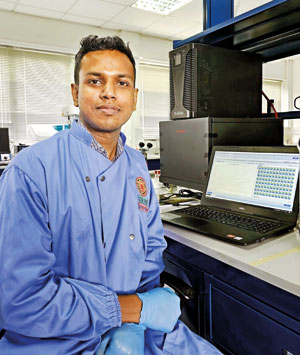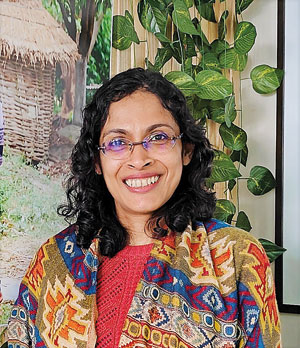News
Epidemic due to vulnerable population and outbreak in India & region
View(s):- J’pura University’s Institute of Allergology and Immunology has sequenced the Chikungunya virus
By Kumudini Hettiarachchi
Debilitating Chikungunya along with Dengue is ravaging certain areas of Sri Lanka, leaving people severely ill and reeling with prolonged disease.
Caused by the CHIKV virus, the vector for both Chikungunya and Dengue are the tiny Aedes mosquito – Aedes aegypti and Aedes albopictus.
Unbeknown to the suffering people, at the state-of-the-art laboratories of the Sri Jayewardenepura University’s Institute of Allergology and Immunology, Chikungunya has been put “under the microscope” to garner valuable insights into CHIKV.

Dr. Tibutius Jayadas
“Yes, we have done sequencing of CHIKV, led by Dr. Tibutius Jayadas, a senior research fellow in our laboratory,” says Prof. Neelika Malavige, Head of the Department of Immunology and Molecular Medicine, paying tribute to this scientist for all the hard work done.
These sequencing results show:
n The current Chikungunya strain creating severe illness in Sri Lanka is of the Indian Ocean lineage.
n Unsurprisingly, this strain is most related to strains in India.
n The mutation analysis within the virus has revealed that the current strain has the particular mutation which increases its infectivity and also allows the virus to be effectively transmitted by the Aedes albopictus mosquitoes, apart from Aedes aegypti.
Explaining that sequencing the genome of a virus causing disease in humans is vital in understanding its characteristics, tracking its spread and also to develop effective treatment and vaccines, Prof. Malavige says that identifying the virus’s genetic make-up, including its unique features and mutations is important in understanding its biology, how it replicates and how it interacts with the human body.
The sequencing of CHIKV is part of the ongoing work Prof. Malavige’s department is conducting with the National Institute of Infectious Diseases (NIID – formerly Infectious Diseases Hospital), Angoda, under the programme ‘A2CARES’ (https://www.a2cares.com/). This is funded by the National Institutes of Health (NIH) of the United States of America, the Sunday Times understands, with fears now that the funding may dry up with the change in the US administration.
Prof. Malavige says: “The reason that sequencing is important is because the virus evolves and some strains can give rise to more severe disease than others. These strains may also have an enhanced capacity to be transmitted by mosquitoes. So, it is important to monitor these changes in the viruses.”
As many people would have experienced by now, Chikungunya is a disabling disease in some, she further explains, pointing out however that there is very limited data on why some people get severe disease including arthritis and skin rashes.

Prof. Neelika Malavige
“I believe most people with arthritis would want a cure for it and that is why we are trying to understand these aspects so that we and other scientists around the world can find treatment for disabling infections like these that affect our countries. If we don’t look after ourselves, who else will,” is her simple question.
Next this scientist takes a closer look at the Chikungunya virus status in Sri Lanka – “We are experiencing an outbreak after 16 years, with many patients with symptoms suggestive of Chikungunya being reported from many areas in the country, with most from the Western Province. The Epidemiology Unit would have the official figures on the numbers reported from each district for each month.”
Going into the work performed by her team, Prof. Malavige says that they first identified the virus causing infection in patients admitted to the NIID in December 2024, through PCR (Polymerase Chain Reaction). This was part of long-standing research activities at the NIID, facilitated by Dr. Ananda Wijewickrama and Dr. Damayanthi Idampitiya, to conduct surveillance for Dengue and viruses causing Dengue-like illness.
Contrasting the diseases spread by the same mosquito, she says that although patients with Chikungunya are likely to have more severe disabling joint pain, in some cases lasting several weeks, during the early onset of illness, the first few days, it is sometimes difficult to differentiate it from Dengue.
Chikungunya had first been identified in East Africa in the 1950s, since then causing outbreaks in many countries in Asia, Latin America and Africa. As it is spread by the same mosquito as Dengue (Aedes species), Chikungunya is usually seen in the same regions battling Dengue outbreaks.
Chikungunya outbreaks have been reported in over 110 countries with a surge in global cases. In 2023 alone, 460,000 cases including 350 deaths had been recorded, while so far this year (2025), 80,000 cases and 46 deaths have been reported.
Turning her focus on Sri Lanka, Prof. Malavige says that the country experienced the last Chikungunya outbreak in 2007-2008. Since then there have been no outbreaks until its re-emergence last December (2024).
“There are many reasons for its resurgence, including ongoing Chikungunya outbreaks in the region, with regular outbreaks in India, and the presence of a vulnerable population in Sri Lanka. In the case of Dengue, where there are four viruses that cause disease, there is only one Chikungunya virus,” she says, pointing out that people only get infected with the Chikungunya virus once.
However, Prof. Malavige adds that since Sri Lanka has not had a disease outbreak since 2008, there is a large population who are not immune to the virus (large ‘susceptible’ population). As such, the presence of a large susceptible population along with outbreaks in the region have led to the current outbreak.
| No link between two, except same vector To the crucial query whether there is a possible link between Dengue vulnerability and Chikungunya, Prof. Neelika Malavige gives an emphatic “No”. Even though Dengue and Chikungunya viruses are transmitted by the same mosquito, having had Dengue in the past does not influence disease severity when you get infected with Chikungunya, she says. According to her, newborns, infants and elderly are more likely to get severe disease, while it is not that severe in children, resulting only in a febrile illness (having fever). Older people are more likely to develop disabling arthritis. Complications such as hepatitis and sometimes neurological issues are more likely in the elderly and those with co-morbidities (two or more diseases).
| |
The best way to say that you found the home of your dreams is by finding it on Hitad.lk. We have listings for apartments for sale or rent in Sri Lanka, no matter what locale you're looking for! Whether you live in Colombo, Galle, Kandy, Matara, Jaffna and more - we've got them all!

